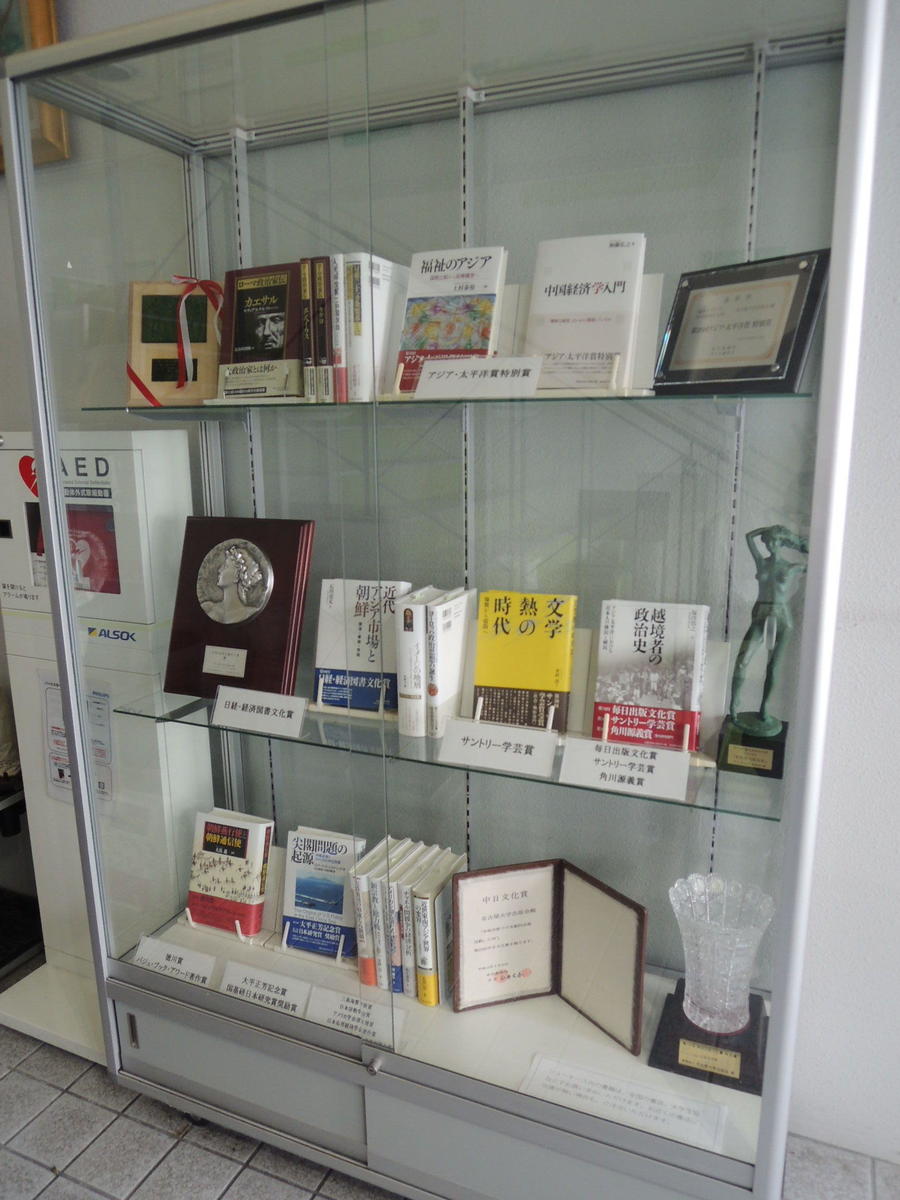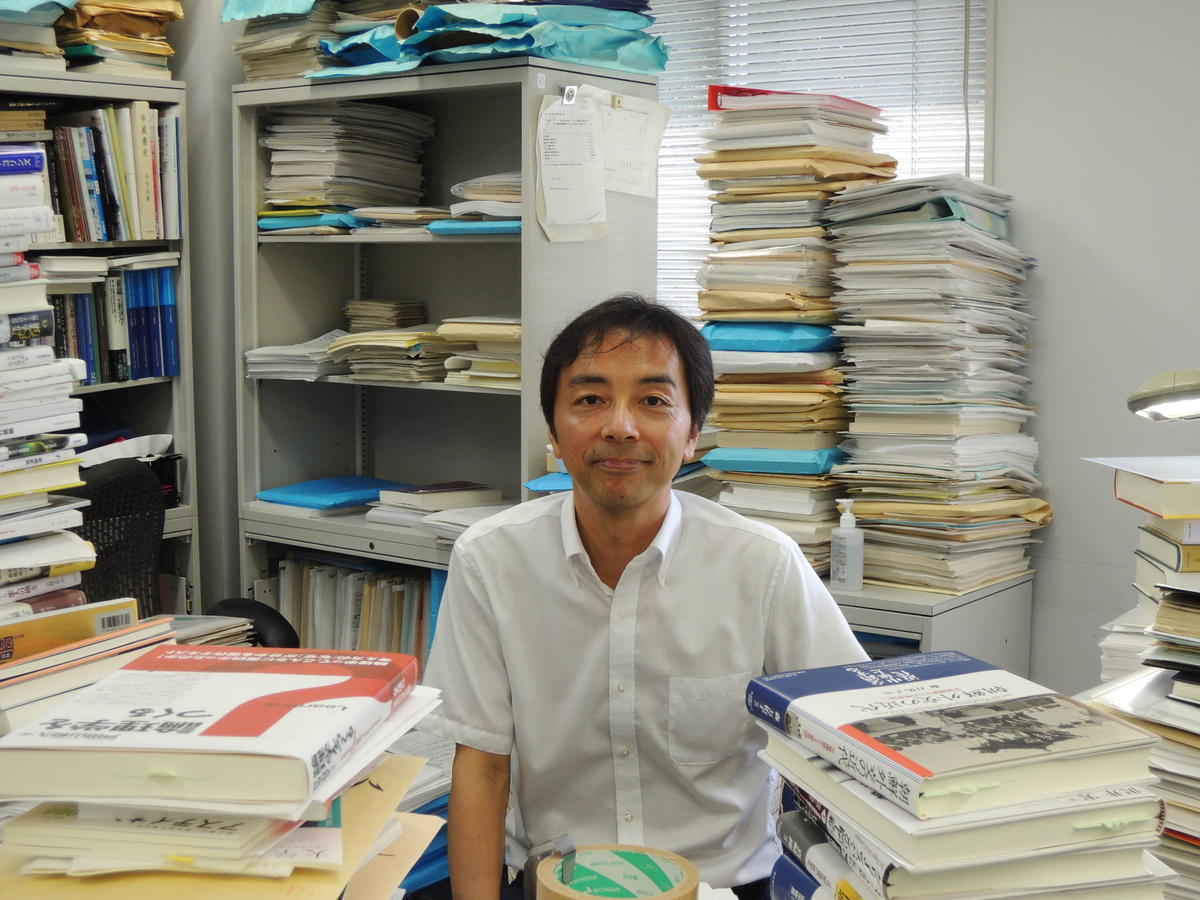September 5, 2017
Ambition and Courage in Academic Publishing
One of the things Nagoya University can boast about is The University of Nagoya Press. I heard this from an acquaintance in Tokyo. The university press may be small but punches well above its weight in the quality of its output, I'm told, with a remarkably high success rate in winning academic publication awards. I have been tasked to find out what its secret is.
The book review section of the Mainichi Newspapers dated August 13 was unreserved in its praise for this university press, commending "the ambition and courage of the organization that published this book" and observing that "no other academic publishing house can match its vigor at present." The book reviewed here is Essential Scientific Writings in Renaissance Europe, an opus comprising two volumes, each around 650 pages, priced as much as 9,936 yen including tax, and with highly academic content. The reviewer explained that the reason for picking a book like this for a general-interest book review was not just because the content of the book itself merited it but also because they wanted to write about the background of its publication.
The book claims to be a "comprehensive compilation of human knowledge of the universe" and includes 30 scholarly works that are representative of the era, all translated into Japanese for the first time, which include not only scientific writings as we understand the term ― by the likes of Newton, Kepler and Boyle ― but also text covering a broad range of subjects from cooking to hot springs to alchemy. The book is academic in nature but not in the way that rejects non-academic readers. Nonetheless, with the publishing industry in a long drawn-out slump, it certainly takes courage to publish such an ambitious book.
So what is this reputable publishing house, Meidai Press?
Well, as soon as I started, I stumbled. Apparently, the University of Nagoya Press is not part of Meidai. Its English name, the University of Nagoya Press, is a misnomer; the more accurate description would be the "Universities of Nagoya" Press.
The publishing house was founded in 1982 for the purpose of publishing the research output of academics affiliated to "Nagoya University and other universities in the Chubu Region", as well as other authors' works of high academic merit which would not be profitable enough to be taken on by commercial publishers. With its vision of "contributing to the promotion of science and culture in the Chubu Region and in Japan", the Press sought the support of the wider local community. The 10-year anniversary publication of the Press recalls the early days, when academic publishing was at its rock bottom and also extremely concentrated in Tokyo, describing how older university presses watched in bated breath, wondering about the chance of its survival in Nagoya. It absolutely needed to muster the support of the local community and, according to the anniversary book, that was indeed how its success was achieved. The chairperson of the Press is the President of Meidai and the director is a Meidai professor, but the board also includes the principals of local universities as councilors.
The University of Nagoya Press is now a general incorporated foundation, with a rented office in the Meidai Information Plaza building (which was built by the Press) next to the Toyoda Auditorium on the Higashiyama Campus.
I visited Mr. Sougo Tachibana, a senior director of the Press who doubles as the chief editor. According to him, the breakdown of their authors is "one third Meidai, one third Chubu Region and one third other." Although the Press is still firmly rooted in the region, it seems the net is cast wider where needed. This approach has resulted in the publication of 30-odd books each year, totaling 883 titles as at the end of August 2017 and winning 174 awards from various organizations and academic associations. This puts its batting rate (if one ignores the fact that some books win multiple awards) at around 20% ― impressively high indeed.
"What is the secret of your success?", I asked. Tachibana replied:
"We are often asked that, but there isn't anything special. I guess we receive many awards because our books show our authors at their best. We do not set out to win awards; we just focus on making good books. That means good topics and, importantly, good writing."
Many scholars approach them with book ideas, but the editorial team also comes up with its own ideas for books and seeks out best authors to write on those subjects. Tachibana's own book published last summer, Gakujutsusho no Henshusha (Editor of Academic Books) (Keio University Press), explains how Kan Bunmyaku no Kindai (Modern Era in Han Context) by Mareshi Saito was the culmination of more than a decade of work from initial conception until finally the ideal author was found "through fate leading us through distant and tenuous connections." This book also won the Suntory Prize for Social Sciences and Humanities for academics under 50.
The regional split mentioned earlier is the result of the team's endeavor to find the perfect authors for the proposed book topics. Another factor is Nagoya's nature as the crossroads of Japan, where people move with relative ease and freedom, creating a wide-area network of people. "Nagoya is a place where talented people come and go", observes Tachibana in his book.
How about the target audience? "We try to cover a slightly wider field than the purely specialized", says Tachibana. There are of course books of strictly specialized interest such as medical textbooks, but in the case of humanities and social sciences, research subjects often center around topics of interest to the wider public. This allows academic books to expand their scope a little further from the core specialist topic to gain a broader appeal and, by doing that, attract a wider audience.
There were times when university scholars were vocal in expressing their views through publications that went far beyond their narrow specialisms. However, as the academia becomes increasingly segmented into narrow disciplines, the divide between specialists and non-specialists has become so rigid that, Tachibana fears, academics are finding it increasingly difficult to talk about subjects beyond their specialisms. This need not be the way; the knowledge of a scholar inevitably covers fields that are linked to their own, and that should enable them to provide reasonably informed opinions in those fields too. Tachibana feels that it is a duty of intellectuals to pose questions to the wider society even if that may sometimes receive criticisms.
In fact, some of the Press's titles sell in volumes well beyond the norm for specialist academic publications, a sign that their readers include people who come from different fields. Not all are success stories though ― Tachibana concedes that there are titles that did not perform as well as he hoped even though they covered topics of social relevance and could provide empirical answers to current social issues.
 Recent award-winning titles are on display at the entrance of the University of Nagoya Press
Recent award-winning titles are on display at the entrance of the University of Nagoya Press
How do they expand topics out from specialist disciplines?
The Académie Royale des Sceinces and the "Utility of Science" by Professor Sayaka Oki, School of Economics, published in 2011, is based on her doctoral thesis and analyzes the French society and its science and technology in the 18th century, with the Royal Academy of Sciences at the center. Having sought advice from more experienced researchers about turning a thesis into a book, Oki had her own idea of what the general public might want and expected that she might need to revise the approach of the text radically. Tachibana's view as an editor was different; he felt that the original thrust of the thesis had a much broader appeal. His advice was to add a chapter about the revolutionary period to make the book more interesting, but the revision was thankfully much less extensive than Oki initially feared.
"Instead of sticking to some common vague notion of what the general public wants, Tachibana-san offered a perspective with more foresight ―this man's a professional, I thought", recalls Oki.The book received multiple awards including the Suntory Prize and the Japan Academy Medal, and Oki, an associate professor at Hiroshima University at the time of the book's publication, became the first female professor at the Nagoya University Graduate School of Economics in April 2016. The publication of the book from the University of Nagoya Press came about through a mutual connection, a professor at Meidai, who was one of Oki's research advisors and introduced her to Tachibana, who offered the book deal after hearing her research presentation. It appears that this connection eventually brought Oki, a graduate of the University of Tokyo, to Nagoya University.
Another uniqueness of the University of Nagoya Press worth mentioning is that its books are often heavyweight ― Oki's book is over 500 pages long. Not many Japanese university presses publish large-volume books, and some of them even specify 300 pages as the standard length. Tachibana decided to let authors write longer works if they can and want to after seeing how American university presses do not shy away from publishing weighty tomes. Publishing long books is no small undertaking; readers demand more both in terms of content and the quality of writing. It is a challenge for authors and hard work for the publisher. The financial risk is also higher. It takes ambition and courage.
Tachibana's work as an academic book editor is certainly professional, but he says, "when scholars put to paper the work they've spent an enormous amount of time and energy to produce, what I can do to help as an editor is limited." He adds: "Having said that, the form of the book is important. I try to read the manuscript as a typical reader and convey what I feel to the author." His stance is to respect the specialized nature of academic work while providing advice on how to present that to the wider society. This works, I imagine, because of the level of trust academics have in him.
"The Press is invaluable to Nagoya University ― it saves us", says Mitsuki Ishii, Dean of the Graduate School of Law who has long been involved in the Press, initially as a board member and then as the director. He has also published from the University of Nagoya Press.
Tachibana studied French literature at Kyoto University and joined the University of Nagoya Press straight after graduation in 1989 through his supervisor's introduction. He became the head of the editing team in 1997 and has observed the academic world through his numerous visits to the frontline of research at universities.
One thing is troubling him, he says: research is increasingly conducted as short-term projects, and younger researchers seem to be suffering as a result. Put under pressure, they simply do not have the time to look beyond their specialisms. This current shortsighted approach uses up the knowledge reserves that have been built up over the years without adding to them ― "a free ride on the past, free ride on the future", he says.There are very few opportunities for academics to meet and talk to scholars from different disciplines even within the same university, and they often feel that academics from different specialisms are almost like aliens. And this tendency is showing a worrying increase. It is natural that researchers in different fields and with different knowledge work and act differently. In order for the academia to thrive, Tachibana feels that it is important for academics to acknowledge that fact and at least have some respect for those who behave differently from their own kind.
A university press, it seems, is a window into the university that not only opens out to the wider world but also opens inwards into the university itself. It shows to those willing to open their eyes what a rich world of knowledge exists right next to them. It would be a loss not to use this window within the campus, opened with such courage and ambition.
I sincerely hope also that this window will continue delivering more insights into the rich and fascinating world of learning.

 Subscribe to RSS
Subscribe to RSS
